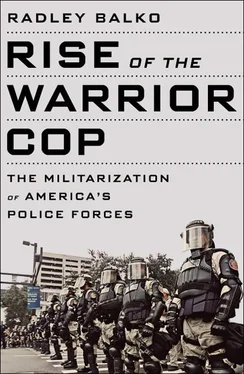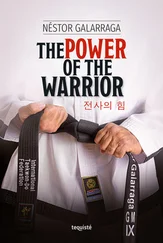THE NEXT CHALLENGE TO THE SYMBOLIC THIRD AMENDMENT came after the Civil War, during Reconstruction. The federal government stationed US troops throughout the southern states to protect ex-slaves from retribution and to enforce the Thirteenth, Fourteenth, and Fifteenth Amendments and the Reconstruction Acts. By most any definition, the troops were an occupying force, performing or closely overseeing nearly all government functions in the former Confederacy.
The mass deployment of troops in the South was made possible by a series of laws called the Force Acts. The first law, passed by Congress in 1870, made it a federal crime to use threats, force, intimidation, or bribery to keep someone from voting based on race or prior status as a slave. It was basically the enforcement mechanism for the Thirteenth Amendment. The second law, passed in 1871, allowed for federal oversight of elections if two or more citizens in any town of more than twenty thousand people requested it. The third law, also passed in 1871, is sometimes called the Ku Klux Klan Act. It gave the federal government sweeping authorization to use the military against any groups suspected of conspiring against federal law. The law also made the terror and intimidation tactics used by white supremacist groups a federal offense and authorized the president to suspend habeas corpus if, in his judgment, other efforts to suppress race-related terror and violence weren’t working.
As long as the troops were in place, Reconstruction worked. The federal presence prevented state and local officials in the former Confederate states from denying blacks the right to vote, barring them from holding public office, or consigning ex-slaves to indentured servitude. The troops also helped prevent mob violence and lynching, although both still happened.
But the disputed presidential election of 1876 put an end to all of that. No candidate won a majority of electoral votes, so the election was decided by a backroom deal between Republican and Democratic leaders. Republican Rutherford B. Hayes emerged as the president-elect in a deal that required him to pull federal troops out of the South, effectively ending Reconstruction. The Compromise of 1877 brought in a new era of mob violence, systematic discrimination, segregation, and general second-class status for blacks that endured for the next eighty years—essentially until the civil rights movement started accumulating victories in the midtwentieth century.
A little over a year after Hayes took office, Kentucky representative J. Proctor Knott introduced an amendment to an Army appropriations bill to bar the enlistment of federal troops for law enforcement purposes without authorization from Congress or the president. Knott’s aim was modest: he simply wanted to repeal the Cushing Doctrine. The amendment to the law, which became known as the Posse Comitatus Act, reads:
From and after the passage of this act it shall not be lawful to employ any part of the Army of the United States, as a posse comitatus, or otherwise, for the purpose of executing the laws, except in such cases under such circumstances as such employment of said force may be expressly authorized by the Constitution or by act of Congress.
The law’s main effect was exactly what Knott intended. It nullified the Cushing Doctrine. US marshals could no longer call up US troops to help them enforce federal law unless they obtained authorization from the president. Some historians and scholars have claimed that the Posse Comitatus Act was fallout from the Compromise of 1877 and that the true aim of its supporters was to repeal Reconstruction. The suggestion is that the law is tainted by racism and sympathy for the Confederacy. There’s some truth to that. The law certainly made it more difficult to enforce Reconstruction.
But Reconstruction was already on the way out. It had lost support in the North. Hayes—a Republican—had even promised to end it during his campaign. And the law actually ended a policy that had been created to catch fugitive slaves. (It’s an unfortunate commentary on the plight of freed blacks at the time that they could be made worse off by a new policy, then made worse off still by its repeal.)
Reconstruction was a necessary policy, and it was probably necessary to use troops to enforce it. But it was a once-in-American-history sort of crisis. The deployments were authorized by acts of Congress. The Fourteenth Amendment required the federal government to protect the rights of black Americans in the South, and it seems clear that a few hundred federal marshals weren’t sufficient for the job. Reconstruction set a new bar for military involvement in domestic affairs, but there’s been nothing like it since. After federal troops were pulled out of the South, the domestic deployment of US troops mostly reverted back to limited situations like large-scale riots and violent insurrections. 24
The term posse comitatus traditionally referred to the population of able-bodied men from which a posse could be drawn. Today both the term and the law have come to represent much more than the text in Knott’s amendment indicates. The law itself is now commonly misunderstood to bar the president or Congress from using the military to enforce federal or state law. That isn’t quite correct. The law only prevents domestic law enforcement officials from using the military to enforce the law without authority from the president or Congress. It puts no restrictions on the Congress or the president. But more broadly, the term posse comitatus has become a signal for the principles behind the Symbolic Third Amendment. It’s often used today to indicate our traditional aversion to putting soldiers in the streets. Regardless of the origins of the term, the sentiment behind it has persisted—often in spite of the best efforts of elected officials. More comforting, one institution that has held the principle in especially high regard is the military itself, although here too there have been a few exceptions.
In the nineteenth century, as America was sorting out when and how and under what conditions the military could be deployed domestically, the country was also growing. By the 1830s, US cities were swelling and becoming more diverse. Predatory crime was increasingly a problem. The country needed new ideas and new institutions for maintaining day–to–day order—institutions that could be scaled to accommodate growing urbanization. Once again the country would look to England for inspiration.
CHAPTER 3

A QUICK HISTORY OF COPS IN AMERICA
Democratic law tends more and more to be grounded upon the maxim that every citizen is, by nature, a traitor, a libertine, and a scoundrel. In order to dissuade him from his evil-doing the police power is extended until it surpasses anything ever heard of in the oriental monarchies of antiquity.
—H. L. MENCKEN,
NOTES ON DEMOCRACY
Colonial American towns were usually filled with people who came from the same place, worshiped at the same altar, and shared the same sense of right and wrong. Historian and criminologist Sam Walker writes, “Crime and sin were synonymous; an offense against God was an offense against society, and vice versa.” 1Predatory crimes like murder, rape, and robbery were almost nonexistent. Far more common were punishments for crimes like blasphemy, adultery, or drunkenness. Not surprisingly, law and policing in prerevolutionary America were modeled fairly closely on the English example. Given the rugged conditions of frontier living and the lack of civic structures, trial and punishment were relatively rare. Mores and shared values were generally sufficient, and when they weren’t, shunning and other forms of informal justice usually worked to keep civic order. Not all colonial communities were the same, and laws varied from place to place depending on the prevailing religion and tradition, but there was little need for state agents to enforce the law. Communities tended to handle transgressors on their own. There were Crown-appointed sheriffs and constables, but again, they largely focused on administrative matters.
Читать дальше














